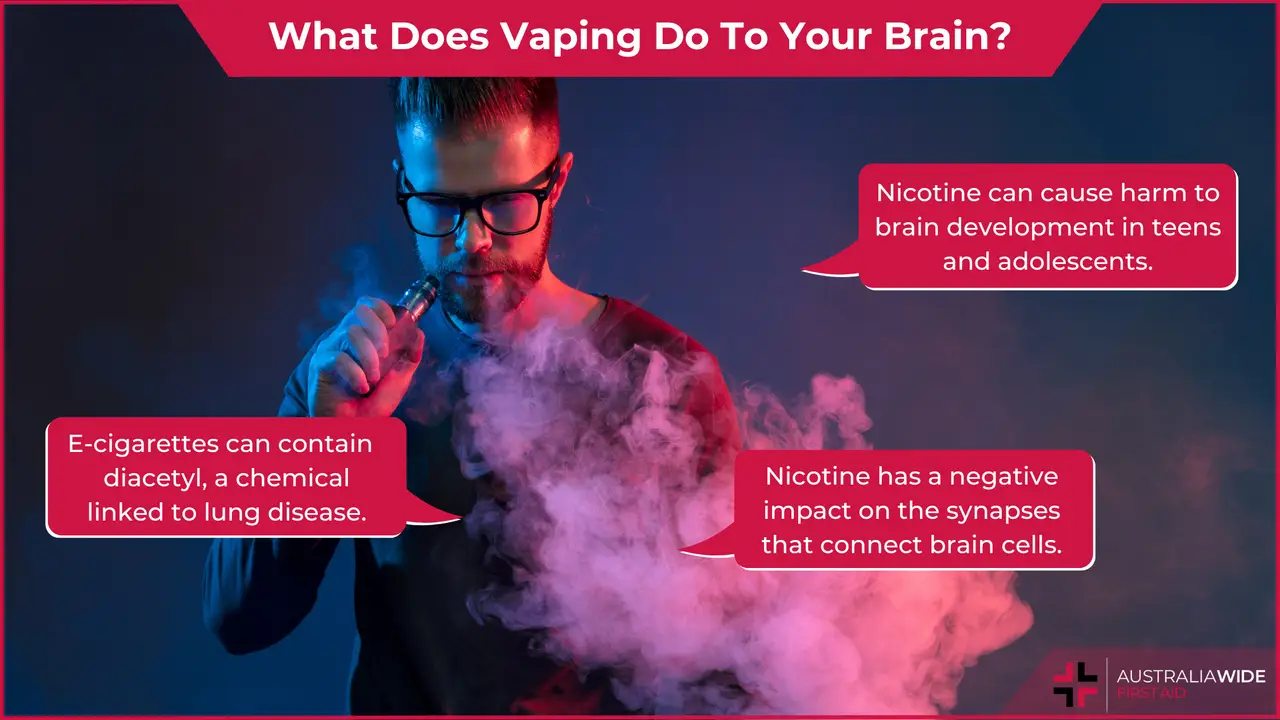What Does Vaping Do To Your Brain?


This article is republished from the University of Nevada, with permission
Vaping has become a subject of fierce debate. Using an electronic cigarette to mimic smoking via inhaling the vapours of a heated liquid has been touted as a healthier alternative to cigarettes and even promoted as a smoking cessation tool. However, emerging research suggests the practice may do more harm than good.
One area of research focuses on vaping’s impact on the brain and brain functionality. Many social work professionals are specifically looking at vaping among teenagers, whose brains are still developing. So, what does vaping do to your brain, and what can be done to discourage it?
The University of Nevada, Reno

Although vaping has been promoted by some as a safer alternative to smoking, several components in e-cigarettes are similar to traditional cigarettes.
The presence of chemicals like nicotine is among the reasons why studies suggest that vaping can contribute to long-term side effects that impact brain function.
Nicotine is found in 99% of e-cigarettes. A highly addictive substance, it may increase adolescents’ risk of becoming addicted to other drugs.
However, nicotine is not the only concern. E-cigarettes also contain other potentially harmful substances. For example, e-cigarettes contain diacetyl, a chemical linked to lung disease. There could also be a link between Click here vaping and cancer, as e-cigarettes also contain cancer-causing chemicals.
Additionally, e-cigarettes contain volatile organic compounds, heavy metals such as lead or tin, and ultrafine particles, which can be inhaled deeply into the lungs.
Research, while still preliminary, has recorded data that suggests serious long-term brain issues may be associated with vaping. Some of this correlates with nicotine’s impact on the brain. Nicotine can cause harm to brain development in teens and adolescents, and can cause the brain to send out signals of nicotine withdrawal symptoms for people of all ages.
There are also concerns regarding the alteration of brain activity. Nicotine has a negative impact on the synapses that connect brain cells. This can spur changes in the brain area controlling essential functions such as mood, attention, learning and impulse control.
Additionally, many vaping devices produce vapor containing lead, which can cause brain damage.
Vaping can also impact more than a person’s brain. The practice can have a negative impact on the lungs, heart, mouth and gums.
While scientific study is ongoing, research suggests a correlation between vaping and negative mental health indicators. These indicators include mood and anxiety disorders, depressive symptoms, and suicidal ideation.
The increased prevalence of vaping among adolescents is a concerning trend for social workers to address. Fortunately, these professionals can turn to several resources and tools to help reduce vaping usage.
Social workers need to clear many hurdles as they strive to reduce youth vaping. One of these hurdles is the acceptance of vaping in public areas.
Another issue concerns the availability of and access to vaping products. Marketing, regulatory environments, cultural considerations and the misperception of vaping as low-risk present further challenges that must be taken into consideration.
Social workers can implement several evidence-based tools and resources into their intervention strategies to reduce youth vaping.
One such tool is the video game intervention smokeSCREEN, which is designed to improve knowledge and dispel misconceptions about vaping.
A second tool, This is Quitting, is a text message program consisting of daily text messages from peers who have quit vaping.
Another resource for social workers to use is CATCH My Breath. This school-based program focuses on vaping and tobacco use prevention via lesson strategies in and out of the classroom.
In addition to evidence-based intervention strategies, social workers can employ several interventions designed to address vaping concerns from a community standpoint. One intervention that can be impactful involves national ad campaigns targeting the prevention of youth tobacco usage, including vaping. These campaigns include The Real Cost campaign from the U.S. Food and Drug Administration and the Truth campaign from Truth Initiative.
There are also several evidence-based prevention policies that can be deployed at the community level. Some of these policies include establishing policies targeting vaping directly, such as advertising bans, packaging laws, point-of-sale laws and flavoured vape bans. Others target elements that can have a residual effect on vaping and vaping habits, like pricing, zoning/licensing laws, the legal age of purchase, clean air laws and increased compliance checks.
All of these strategic components can also be applied to prevent or discourage marijuana-based vaping among adolescents.
Social workers should consider several factors as they implement any type of vaping reduction strategy. There are stakeholder engagements to consider, such as school district officials, health care professionals, child advocacy groups, and city or county officials.
They should also take into account financing, targeting intervention, adaptation vs. fidelity and staff training components.
While there’s still much to learn about vaping, what we do know suggests it’s bad for the brain, especially among youth. By building and deploying careful intervention strategies, social workers can help teens and young adults understand what vaping does to the brain and avoid the risks of vaping.
The original article can be found here.

March 25, 2025
Explore non-traditional paths to sobriety, including mindfulness, yoga, nutritional therapy, and community-based support, for a personalized approach to recovery.

September 7, 2022
Menopause is the final period, when a woman, trans man, or non-binary person assigned female at birth's ovaries run out of eggs and the body can no longer ovulate. Menopause comes with several symptoms, complications, and treatment options.

July 26, 2024
Transcutaneous Electrical Nerve Stimulation (TENS) is a therapeutic method of pain relief. It utilises an electrical device that emits electrical currents and streams the impulses via electrode patches attached to the skin.